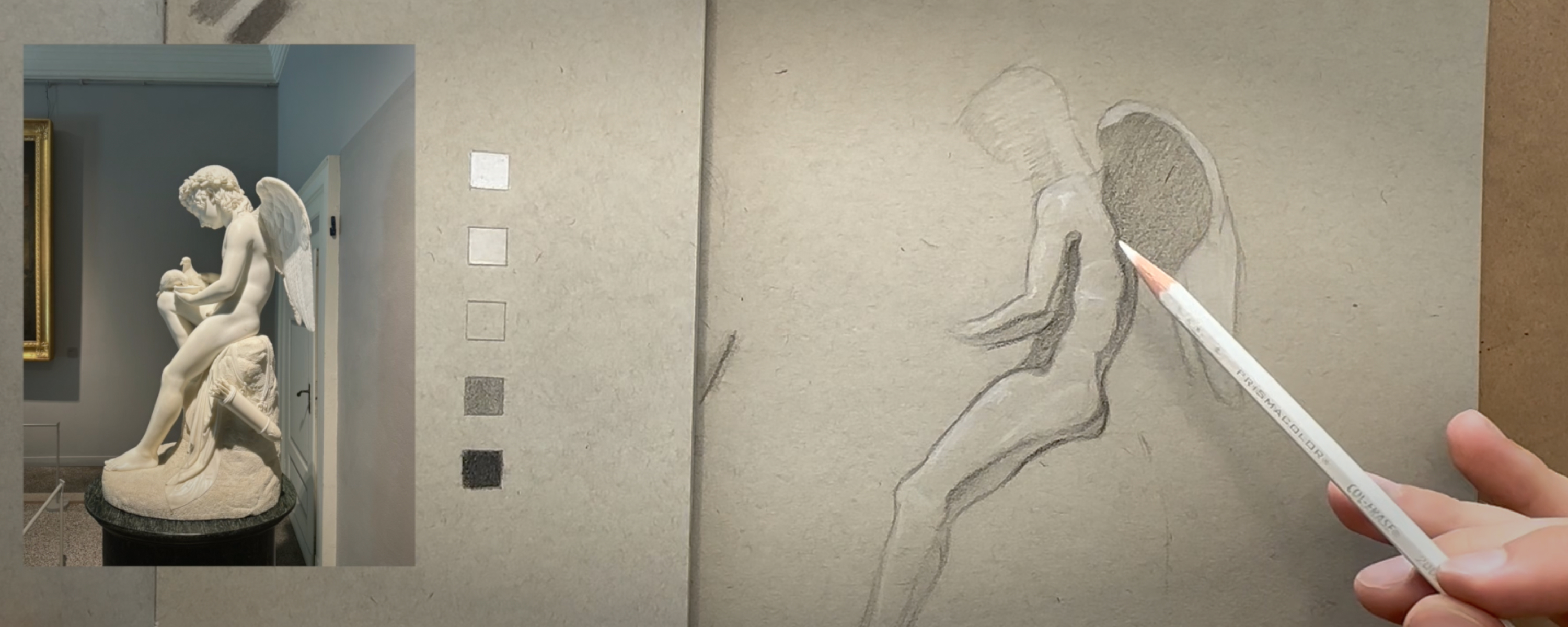Do You Struggle Making Consistent Drawing Progress?
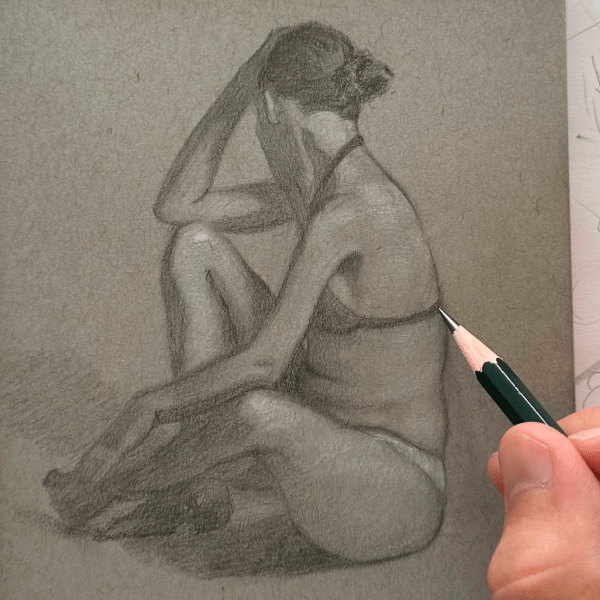
If you answered yes, then you are just like me...
For many years I struggled figuring out how to get better at drawing.
After reading countless books, attending seminars by pro artists, and practicing a bunch, I finally realised what the secret to long-term drawing progress is:
An ever deepening understanding of the drawing fundamentals.
The problem: Most drawing enthusiasts never learn about the drawing fundamentals, how to see them, practice them, and apply them to their work.
And as a result, they don't even give themselves a chance to improve at drawing.
The Course I Wish I Had When I Started Drawing Many Years Ago
Drawing Fundamentals In 7 Days will help you:
- Move from “spinning your wheels” to consistent long-term progress by learning the drawing fundamentals.
- Learn how to practice each fundamental directly using targeted exercises, and how to apply them in an actual figure or portrait drawing.
- Train your eye to “see” which drawing fundamental is lacking in your work, and know how to improve it.
So that in a few months you are impressed by how much more beautiful, impactful and well-designed your drawings are!
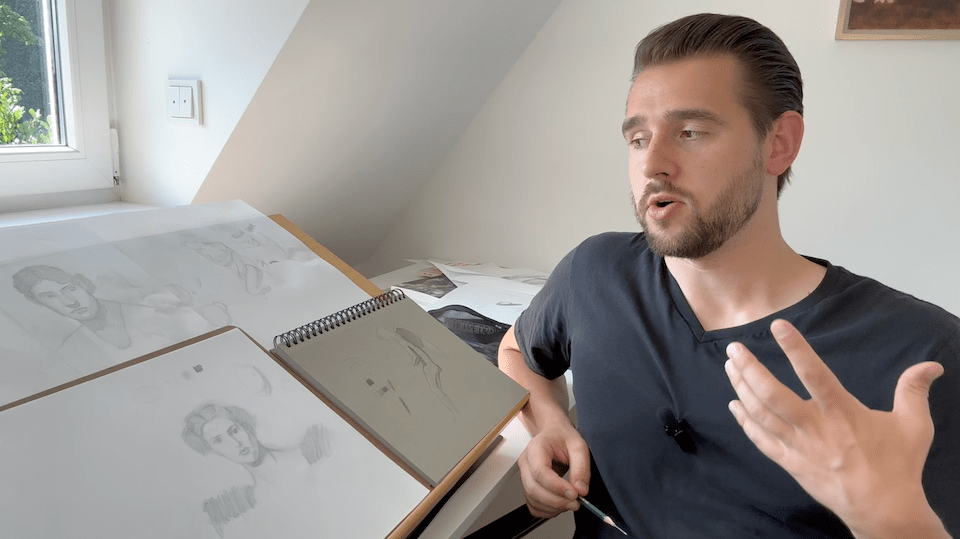
Drawing Fundamentals In 7 Days - Curriculum
Check out the preview videos or scroll further down the page for detailed descriptions of what each module covers.
- Materials Overview & Approach (7:05)
- The Best Drawing Tools For Beginners (16:09)
- Sharpeners, Erasers & Blending Tools (19:38)
- Paper, Sketchbooks, Easels & Other Accessories (11:04)
- Graphite Pencils & How To Use Them (10:44)
- Black & White Pencils On Toned Grey Paper (4:31)
- Charcoal Pencils (3:41)
- Other Drawing Tools (5:20)
- Pencil Cases & Travelling (7:35)
- Introduction To Tonal Mark Making (5:23)
- The Keys For Tonal Drawing: Overhand & Backend Grip (10:12)
- Drawing With Erasers & Blending Tools (6:32)
- Practicing Tonal Mark Making - Exercises (11:16)
- Value Scales (15:39)
- Value Gradations (6:41)
- Applying Tonal Mark Making - Figure Demo Part 1 (50:13)
- Applying Tonal Mark Making - Figure Demo Part 2 (32:51)
- Introduction To Values & Edges (4:44)
- 2 Value Studies - Theory (3:47)
- 2 Value Studies - Velazquez Master Study (24:07)
- Rendering & Edges - Theory (4:06)
- Rendering In Black & White Pencil On Toned Paper - Demo Part 1 (29:10)
- Rendering In Black & White Pencil On Toned Paper - Demo Part 2 (18:53)
- Rendering In Black & White Pencil On Toned Paper - Demo Part 3 (13:36)
- Introduction To Form (2:58)
- How To learn Form Drawing (4:58)
- Intro To 1-, 2- & 3-Point Perspective (8:14)
- Linear Form Drawing Techniques - Figure Demonstration (35:58)
- Intro To Tonal From Drawing (1:46)
- Light & Modelling Factors (28:51)
- Tonal Form Drawing Techniques - Sargent Portrait Master Study (44:35)
What's Included In Drawing Fundamentals In 7 Days?
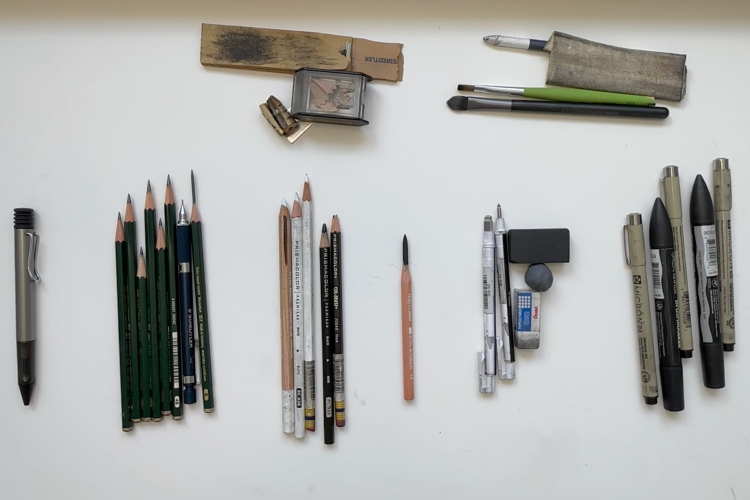
Day 1: Materials
Materials are a crucial part of your drawing success. In the end, where the drawing tool meets the drawing surface, is where all the magic happens. And how you use your tools and surfaces matters.
This section gives you the material overview I wish I had when I started drawing. The right materials can help you study more effectively, while an unawareness of your materials can hold your drawings back, without you realizing why.
This module covers:
- The best drawing tools for beginners, which are both practical AND versatile, for linear and tonal drawing.
- You’ll learn about 3 types of sharpeners, and when to use each, 5 types of erasers and how to use them as drawing tools to draw “in the lights, and several blending tools to create smooth tones.
- You’ll learn about which papers and sketchbooks are great for studying at home and while traveling, and other accessories like easels and drawing boards, which can make your practice even more comfortable.
- You’ll get a deep introduction to graphite pencils, that won’t overwhelm you but show you the key ways to use graphite for a range of values, without having to carry 20 pencils around with you.
- You’ll learn how to use black and white pencils on toned grey paper for cool “form effects”, to get that illustrator drawing type look.
- We’ll also introduce charcoal pencils, and other drawing tools like pastels and inking.
- Lastly you’ll learn about the importance of choosing the right pencil case that suits your practical needs AND inspires you to draw, at home and while traveling.
-
All in all, you’ll come away with a clear sense of how to think about materials in the success of your drawings, and how you can adapt them to your exact needs
Day 2: Linear Mark Making
Most drawing beginners never learn about how to correctly make a mark with their drawing tool.
The result: Hatchy, incorrect, ugly marks. Learning about mark-making was a major epiphany for me, and has the potential to improve your drawings within days.
This module covers:
- How to make confident, beautiful and correct linear marks, and how to consciously design your drawings using 3 types of lines.
- Specific exercises you can practice anytime, anywhere to improve your mark-making skills. Just 5 minutes a day for 2 weeks can level up your drawings tremendously.
- Posture: The key to confident marks, that's rarely talked about.
- Head & Subject Positioning: The secret to avoiding distortions and improving accuracy, that's often overlooked.
-
Figure Drawing Demonstration: See how to apply linear mark making in an actual drawing, and experience how this fundamental translates into more beautiful final drawings.
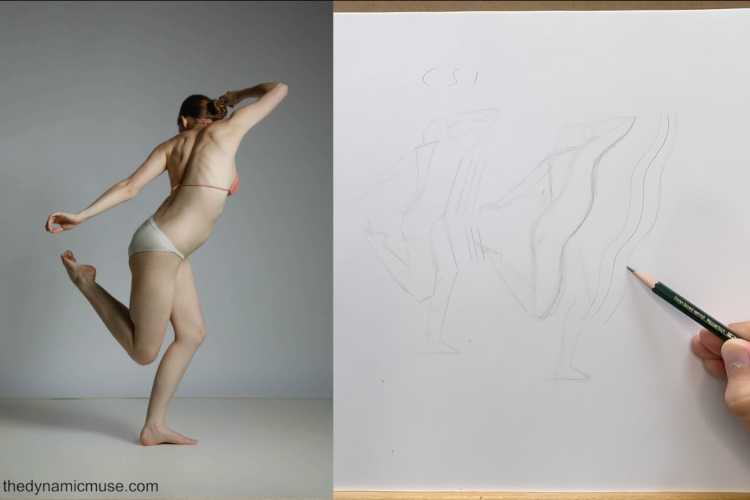
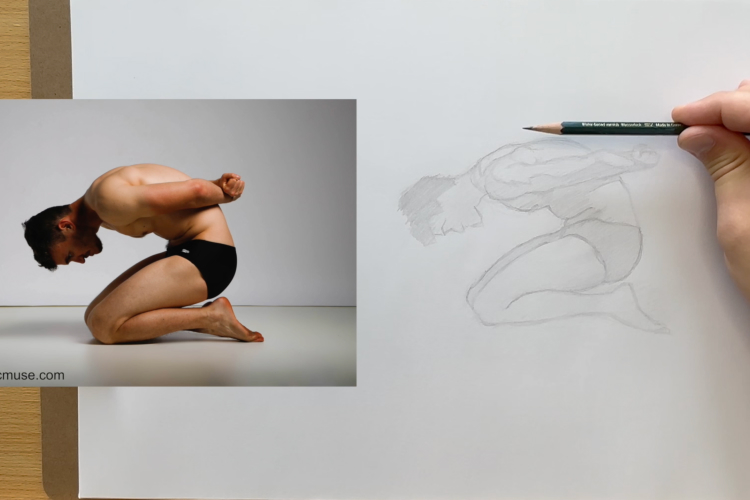
Day 3: Tonal Mark Making
Tonal mark making is the natural progression from linear mark making, and a key to realism. Yet many drawing enthusiasts never learn how to make proper tonal marks. Personally it took me years to find out how to draw tonally, as I’ve found the information on this topic is very scattered and hard to compile.
This module covers:
- The 2 grips you need to master for tonal drawing. Learning just these 2 techniques increases your versatility immensely, and was one of those great epiphanies in my drawing Journey.
- How to draw with erasers and blending tools, to create interesting light effects and smooth tones in your drawing.
- Specific Tonal Mark Making Exercises, you can practice daily for fast improvements in the look of your drawings.
- Your 2 best friends: Value scales and value gradations. How to practice them, and how to apply them in your drawings.
-
Figure Drawing Demonstration: Learn how to apply tonal mark making to create drawings that have depth and atmosphere.
Day 4: Measuring & Shape Design
In this module you’ll learn freehand measuring techniques that create stronger accuracy and likeness in your drawings (how closely your drawing matches the subject you are drawing), while at the same time showing you that shape design is actually what you are after.
Shape design has a huge impact on your drawings, and I'm excited for you to learn about this critical drawing fundamental.
This module covers:
- Intuitive freehand measuring techniques: how to get a likeness using angles, plum lines, triangulation, negative space and more.
- The actual key to likeness: How to see and design shapes.
-
The most effective way to practice shape design: Watch me study shape design, as I demonstrate a John Singer Sargent shape design master study.
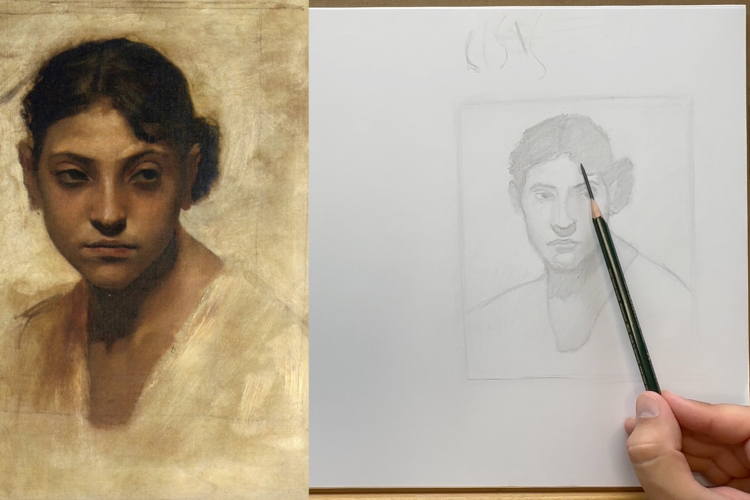

Day 5: Gesture
Gesture is about capturing the dynamic, flowing, emotional nature of whatever you are drawing, instead of just copying it.
With gesture, your drawings look dynamic, and full of movement. Without gesture, your drawings look lifeless and stiff. The good news: Gesture drawing is fun to practice, and you'll learn how in this module!
This module covers:
- What gesture is, and why practicing gesture drawing has the potential to transform your drawings
- How to study gesture from the great masters: John Singer Sargent Gesture Study
-
Gesture drawing demonstration: Watch me as draw several figure and portrait gestures, so you can follow along.
Day 6: Value & Edges
Value is a critical layer of any image, and as fundamental as line or shape.
This module shows you simple concepts to apply value to your work, to create drawings with greater atmosphere and depth.
This module covers:
- How to get a strong read using 2-Value studies, and why they have the potential to greatly improve your drawings.
- 2-Value Velazquez Study Demonstration in black marker. Learn how to train your eyes to see in 2 values using this highly effective exercise.
- Learn how to render a drawing in several values for enhanced realism, using black and white pencils on toned grey paper.
- Sculpture drawing demonstration: You’ll get access to a deep rendering demo of a sculpture, using black and white pencil on toned grey paper.
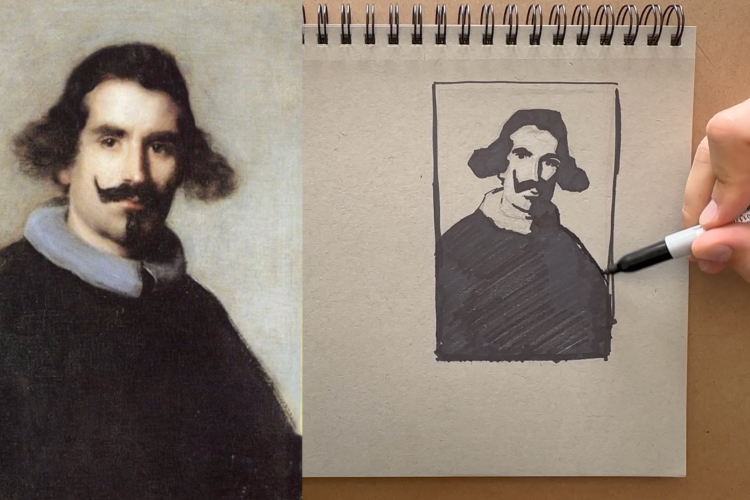
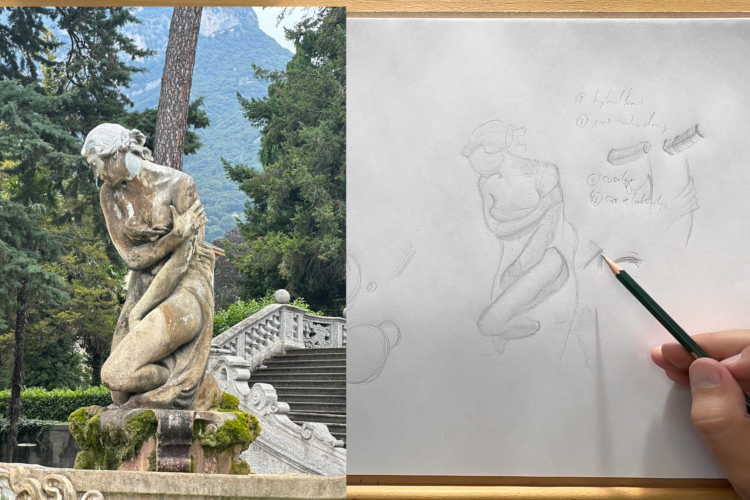
Day 7: Form
Last, but definitely not least, we’ll cover form.
Form is about creating a 3D looking drawing on paper.
While line, shape and value can already create beautiful drawings, mastering form principles will truly help you get that “pop”, and make your drawings come off the page.
This module covers:
- How to create the illusion of a 3 dimensional drawing on a 2 dimensional paper
- Linear form drawing techniques, and how to use cross-contour drawing to render drawings in 3d space
- Tonal form drawing techniques, and how to "mass" form into your drawings, like a sculpturist uses clay
- Introduction to 1-,2- and 3-point perspective
- The most effective exercise to train your eye to "see" form
- Form Drawing Demonstration: Watch me demonstrate linear form drawing techniques, and learn how to design a form's roundness or boxiness.
- Form Drawing Master Study: Watch me demonstrate tonal form drawing techniques as I study a John Singer Sargent portrait, and describe a plane in tone.
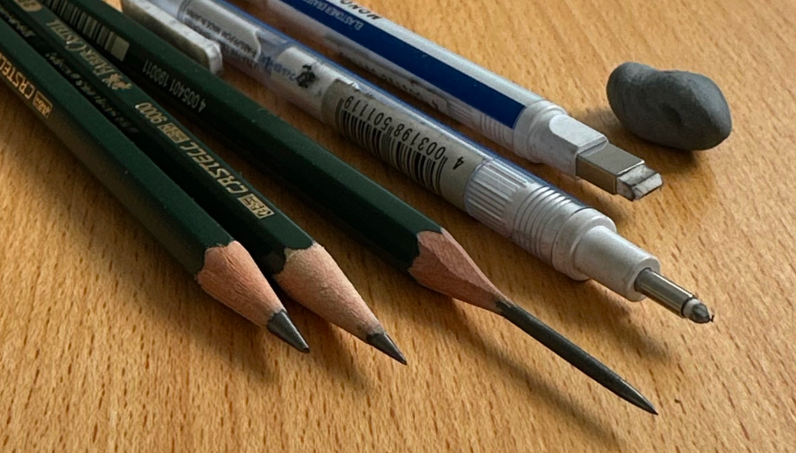
Bonus #1: Self-Study Resource Guide
- List of the very best 1-3 instructional books I ever read on each drawing fundamental, so you have a clear path to dive deeper in your studies.
- The list includes recommendations on anatomy, composition, creative process and more.
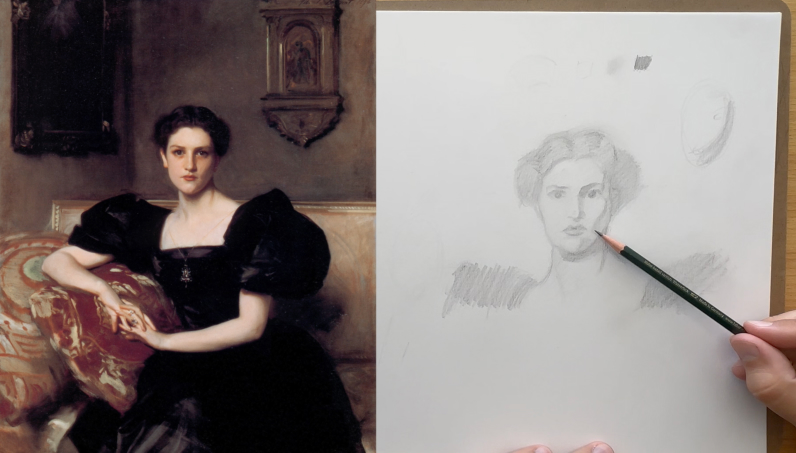
Bonus #2: Reference Guide & Master References
- My very favorite Master References that you can study using the exercises of this course, to level up your design skills.
- A list of the best reference sites on the internet, so you can start drawing now.
How The Drawing Fundamentals Changed My Life
I’m not sure when exactly it happened, but drawing inspired me from a young age, and I wanted to learn it.
While I was hooked by that initial spark of inspiration to learn drawing, I often felt very lost during my practice phases.
"How do I actually get good at this? And what is drawing exactly anyway?"
One of the first breakthroughs came when I discovered Betty Edward's famous instructional book “Drawing On The Right Side Of The Brain”.
By practicing her exercises I was able to draw realistic-looking objects and figures by observing and meticulously copying lines and values.
It was exciting at first, as I thought I finally cracked the "realism secret", but it quickly led to new frustrations:
Finishing a drawing took hours and the process was very arduous.
I felt like there must be more to drawing than just being a human copier machine. While helpful in teaching me to see basic visual concepts, the approach completely lacked expressiveness, design, and other elements, that I couldn't verbalize at the time. All in all, I felt unskilled.
"There must be a better way."
After many hours of research, reading over a hundred books, and going to a bunch of seminars by pro artists, I learned drawing concepts that I had never heard of before.
These concepts improved the look and professionalism of my drawings, and they made drawing more fun, and gave me a sense of control and skill. Some of these concepts were:
- How to make fluid, confident marks
- How to balance measuring and shape design
- How to draw tonally
- Realising the power of materials, and how to make material experiments
- Getting a sense of design in all visual elements of a drawing (line, shape, form, value, edges)
- Gesture, and how to breathe life into your drawings
- Form drawing techniques, and how to imagine an object in 3D space while drawing
- any many, many more...
Each time I learned about one of those concepts, it transformed my drawings, and each time I thought the same thing:
“ I wish someone would have given me an overview of these drawing fundamentals, right when I started drawing...
... because even if I can’t master them all at once, and it will take me years to get good at all of them, at least I would have understood clearly from the start which fundamental skills I need to study to get great at drawing, how to see them play out in my work, and how to practice them directly.”
And I noticed I wasn't alone in that thought!
Helping out in drawing forums on Reddit, answering posts, I realised the struggle is the same for many who want to learn drawing.
- “What are the drawing fundamentals, and how do I practice them?”
- “Why do I spin my wheels and don’t progress?”
- “I'm inspired to learn drawing, but somehow it feels so boring to practice?”
And that’s how the idea of the blog, and ultimately this course came to be.
I wanted to share the lessons I gathered from reading hundreds of books, years of practice, attending several seminars by pros in the field, and distill them into a perfect course for beginners.
The Secret To Getting Great At Drawing
To get great at drawing you need to make consistent progress, week over week, month over month, over several years.
You do that by looking at your most recent drawing, and identifying which drawing fundamentals are applied well, and which ones are holding back the drawing.
Then you practice the fundamental that is holding you back directly and learn to apply it in your next drawing in a way that achieves the look you want. Then wash rinse and repeat the process.
Sounds simple?
It can be that simple, if you understand what the drawing fundamentals are, train your eye to see them in a drawing, and know how to practice them directly through exercises.
And that's what Drawing Fundamentals In 7 Days is going to teach you.
Is Drawing Fundamentals In 7 Days For Me?
This course is perfect for you if:
- You are passionate about drawing, want to get great at it, but were never clearly shown what you need to study to achieve that.
- You are a beginner and want to build a solid foundation for long-term progress.
- You have been drawing for a while but struggle to improve.
You know this course is for you, if you've experienced one of the following:
- One day your drawings look great, only to look really bad a few days later. Your results fluctuate and there seems to be inconsistency in your ability to create beautiful drawing. You feel out of control.
- When you look at the drawings from half a year ago they don’t look better than your most recent ones. Your progress is slow or non-existent.
- While you can draw by observing and copying, you struggle to create drawings that look realistic, but also have a unique design in line, shape, value and form, and they lack an impactful impression that’s truly yours.
-
While drawing inspired you and that’s why you started to learn it, you feel like it’s boring to practice, and you’re not sure how to make it fun and tap into the potential of this exciting art form.
Frequently Asked Questions
Does Drawing Fundamentals In 7 Days cover all topics from the Drawing Fundamentals Definitive Guide blog article?
The course does not cover anatomy & composition. The reason is that materials, mark making, measuring & shape, value, edges and form, really cover all visual fundamentals.
- Composition is the arrangement of line, shape, value and form.
- Anatomy is about learning how to apply line, shape, value and form to actual figure drawings.
By learning the fundamentals in this video course, you can pick up any composition or anatomy book and start studying it, as you got the fundamentals needed to learn composition and anatomy. Those topics might be covered in more depth on the blog in the future.
What’s the subject focus of this course?
This course is focused on figure and portrait drawing with an expectation of some degree of realism. It is not about manga, comic, or other specific art forms, even though these fundamentals apply to any drawing art form.
How deep does Drawing Fundamentals in 7 Days go into each fundamental?
I have been drawing for many years, read hundreds of books, and attended many seminars.
In Drawing Fundamentals in 7 Days I explain each fundamental how I wished someone would have explained it to me when I started.
By the end of the course you will have a clear understanding what the fundamental is, practical exercise demonstrations on how to practice it, drawing demonstration of the fundamental in action, and tips on how to study it long-term.
The beauty of drawing is that long-term progress comes from going deeper and deeper into each fundamental, and it takes a lifetime to go really deep. But for a beginner, or someone who has been drawing for a while and spinning their wheels, just going from 0 to decent in each fundamental will improve your drawings a lot.
So while you won’t know everything about each fundamental after the course (it takes a life-time), you’ll have a solid understanding of how to use them, effective exercises in your toolbag to practice them, and an appreciation of how to get better at them in the long-run with consistency and control.
Will There Be More Courses In The Future?
Yes, I plan to release more courses on specialty topics, that dive deep into certain areas of drawing. There will also be more free articles coming on my blog.
